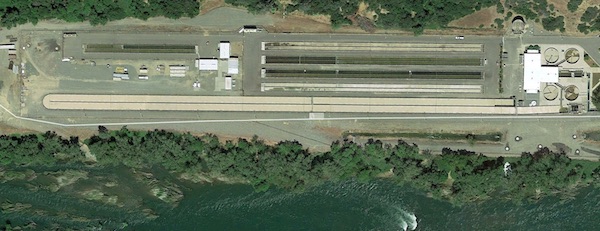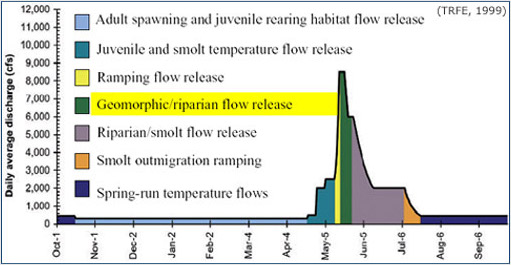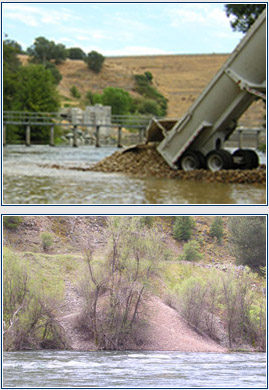Reach Scale
Reach Scale Intro
The goal of reach-scale rehabilitation is to restore populations to pre-impact levels and provide the resources for river self-sustainability.
Current biological management practice in many cases is to use hatcheries to manufacture fish and not worry about the river's physical condition. Decades of hatchery production is harming the diversity of salmonid populations, yielding smaller and less-fit individuals.
Scientists have hypothesized that it is possible to restore wild populations for the entire aquatic community, including but not limited to just a few fish species.
Different specific hypotheses for how to do this involve a variety of "active" and "passive
tools. Active tools involve direct and usually recurring interventions to establish river functionality and keep the river functional. Passive tools involve taking action to get out of the way of the river to the extent possible and allowing the river to heal itself. Active tools assume we have the knowledge and capability to achieve our goals correctly, while passive tools assume the river has the capability to heal itself when often it does not.
Some experiments testing some hypotheses about reach scale SHR are underway, but it will take decades before we know what works. In general, managers are overconfident in their beliefs of reach-scale SHR strategies.
Biological Solutions?

- Data shows that hatcheries are hurting fish genetics.
- "Ecological and genetic diversity help stabilize salmon production. And when production is based on a few large hatchery programs, both the genetic and ecological diversity is reduced. The result is salmon production is much more vulnerable to productivity cycles and human impacts." -James Lichatowich
- "Recent work has indicated that a natural flow regime is one of the most important factors in maintaining native CA stream fish communities." -Brown, 2000
Natural Flow Regime Hypothesis
- The natural flow regime is the time series of flows on a river.
- This regime is composed of cycles of rise and fall, predictable events, and unpredictable random events.
- Different aspects of a natural flow regime serve different geomorphic processes and ecological functions.
- The natural flow regime hypothesis for reach-scale SHR posits that we can achieve benefits from re-regulating dam operations to release water in a way that mimics individual elements of the natural flow regime.
- The example below shows a conceptual hypothesis for restoring functionality on the Trinity River below Lewiston Dam.

Sediment Conveyor Hypothesis

- Just as rivers have a natural flow regime, they also have a natural sediment supply regime.
- Sediment supply refers to the material that erodes off the landscape and enters a river.
- The sediment conveyed and stored by mountain rivers, especially coarse materials like gravel and cobble, provides the diverse assemblage of structural habitats, from pebble clusters to geomorphic units.
- Dams block the natural flux of sediment down a river.
- To address the lack of coarse sediment supply below a dam, the sediment conveyor hypothesis speculates that adding suitably sized gravel and cobble below a dam will provide the raw materials the river needs to rebuild its own in-stream features.
Floodplain Access Hypothesis
- Natural rivers spill water and sediment over their banks onto low-lying peripheral lands every 1-5 years.
- This sediment, often sand and mud, creates and sustains a diverse assemblage of floodplain landforms and their habitats.
- Therefore, it is hypothesized that giving rivers more access to floodplain space will enable a river to re-build its own natural riparian corridor.
- This can be done by making breaks in artificial levees, setting levees back further from riverbanks, removing buildings from floodplains, and removing levees entirely.

Reach Scale Challenges
- Channel form and flow regime on a regulated river are decoupled due to extensive engineering and impacts of dams. Thus, the ability of a river to re-form itself under existing conditions, even with a more natural flow regime is largely unknown.
- Several journal articles have now been published that refute the natural flow regime hypothesis for river restoration in some settings. See Pasternack, G. B. 2008. Spawning habitat rehabilitation: advances in analysis tools. In (D.A. Sear, P. DeVries, S. Greig, Eds) Salmonid spawning habitat in rivers: physical controls, biological responses, and approaches to remediation. Symposium 65, American Fisheries Society, Bethesda, MD, p. 321-348.
- If a channel is going to be "down-sized" from its pre-dam geometry to fit the available flow from dam re-regulation, how will the river carve an appropriately sized meander belt into a mountain range and road network currently matching a much larger channel configuration? In other words, you cannot just down-size a few channel metrics without considering all the metrics, and this is sympotomatic of the mimicry approaches commonly used.
- Rivers have thresholds for self-maintenance. If flow and sediment additions are below such thresholds, then no benefits will result.
- If re-regulated flows are below the thresholds for other processes not considered in the design phase, then the new regime won't work. An example is that the threshold for ripping the roots of riparian shrubs and trees out of the ground is very high and often not achieved by designed flows. As a result, channels may become overgrown with vegetation in the decades after flow re-regulation.
- Systemic change associated with reach-scale SRH strategies will take decades to centuries, which means that it will be a long time before it is known whether they are working and it also means managers have to stick with actions long enough to give them a chance to work. However, politicians, managers, and society almost always lack the patience to do this, instead continually tinkering and re-disturbing a system.
- Massive sediment injections and flow re-regulations will continue a history of unpredictable river disturbance complicating the establishment of resilient geomorphic processes and ecological functions. Consistent fitness criteria for natural selection may not become normalized.
Reach Scale Practical Obstacles
- Besides the large gaps in scientific knowledge for reach-scale SHR, there are many practical obstacles.
- How do you get tens to hundreds of thousands of tons of gravel and cobble into a river, especially when/where policies and regulations greatly restrict the seasonal window for such activities?
- For many rivers there are bridges, homes, buildings, land uses, and other societal activities that need to be moved out of the river's way for re-regulated flows to be permitted.
- Will the political will and financial resources last enough years to decades for real benefits to accrue?
